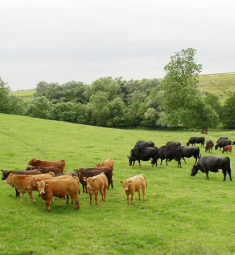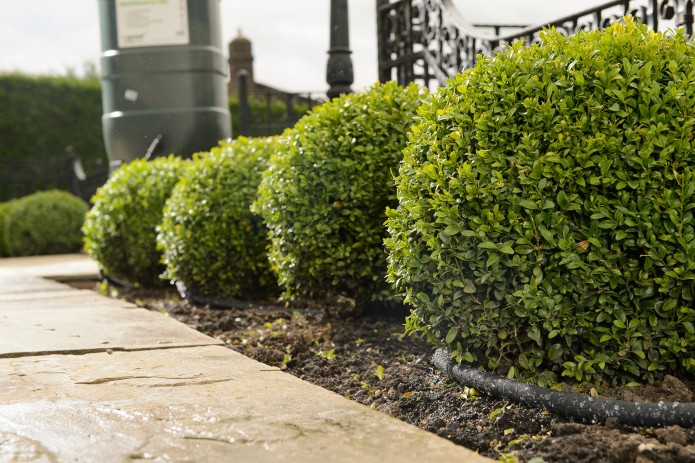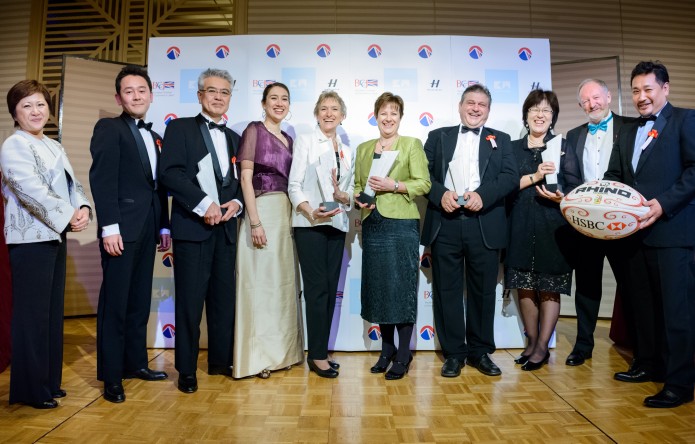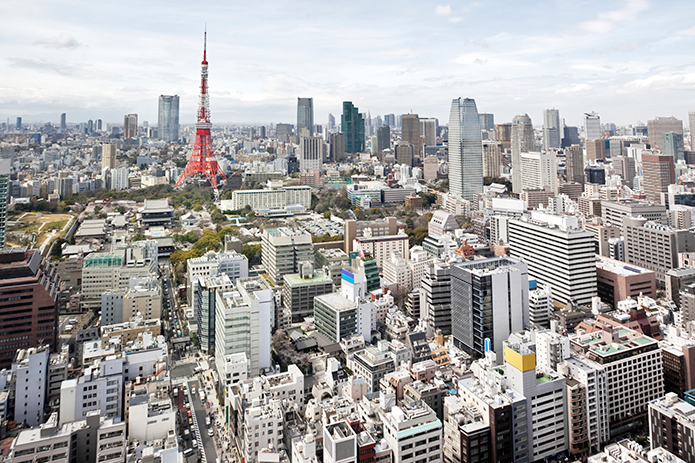
Peter Hardwick: British beef is special and delicious.
Despite same risk status as Japanese beef, the British variety has been banned here for 16 years but could be back soon
• British beef could return here soon
• Banned due to BSE since 1996
• Tokyo negotiating with EU nations
• French, Dutch leading stampede
Coming from herds of Aberdeen Angus, Belted Galloways, South Devons and Welsh Blacks, British beef is recognised as among the finest in the world.
The UK beef industry undoubtedly sustained a major blow after bovine spongiform encephalopathy (BSE), or mad cow disease, was discovered and its implications recognised. However, 16 years after British beef was banned in Japan, there are hopes that it could return to menus here in the not-too-distant future.
According to Eblex, the organisation set up to promote English beef and sheep production, this revelation is excellent news for British farmers, restaurant owners in Japan, and anyone who enjoys a tasty and tender steak from top-quality beef raised in the perfect environment.

Exmoor has some of the finest grazing country.
“British beef is characterised by being very natural and is produced through pasture-rearing—principally on grass, as opposed to being grain fed”, Peter Hardwick, head of trade development for Eblex, told BCCJ ACUMEN.
“This is one of the few things for which we can thank British weather!
“The climate, coupled with the nature of our countryside, makes it perfect for naturally grown grass on which ruminants can graze”, he said. “As well as a strong sustainability message, we believe this gives our beef a special and delicious flavour”.
As home to some of the great beef breeds, Britain is where line breeding techniques were first implemented by agriculturalist Robert Bakewell (1725–1795). As a result, the nation became the first to breed livestock systematically and selectively.
In addition, the UK has other protocols in place. It has developed sophisticated, whole-chain assurance systems that provide guarantees on traceability, and have strategies in place to protect animal welfare. The latter are particularly important in terms of minimising stress, recognised as a major cause of toughness in meat, while the promotion of post-slaughter techniques helps to improve the quality of the meat.
“And this is on top of the breeding and on-farm work that optimises the animals for beef production”, Hardwick added. “Of course, we do not pretend to produce Kobe-style beef, or wagyu, but we do believe we have a product that matches and outperforms that imported from elsewhere”.
Underlining this bold claim, Eblex, a division of the Agriculture and Horticulture Development Board, pointed out that British beef from a West Country producer won a 2010 competition organised by a Belgian gastronomy magazine to find the best steak in Belgium.
The judging panel was made up of chefs and culinary journalists, who compared a range of rib-eye steaks from countries around the world, including the US, Australia, Argentina and EU nations.
“Belgium is a country with an outstanding culinary tradition and they unanimously picked the English beef matured on the bone as being the best of the bunch”, said Hardwick.
The judging panel commented that the winning beef was “very tender with lots of character and excellent texture” and had “succulent fat and a pronounced taste”.
Nevertheless, there is no escaping the fact that the industry was badly damaged by the outbreak of BSE, which could be traced back to a cow in the UK that fell ill in 1986.
The UK was the country most affected by the disease, as a result of which 4.4mn cattle were slaughtered in the subsequent eradication programme.
In March 1996, the EU introduced an export ban on UK beef to its member nations. It remained in place until May 2006.
The presence of BSE in cattle has been reported by some 30 countries, including the US and Canada, while 26 cases have been identified in Japan.
Following the BSE crisis in Europe, Japan imposed a ban on all beef imports from the EU. The ban remains in place, although two EU member states—France and the Netherlands—have applied to the Japanese authorities for their cattle to be given a clean bill of health, and for a lifting of the ban as it applies to their beef.
The UK is in the process of filing the same application. However, the Japanese authorities are handling the matter on a country-by-country basis, and British beef has not yet reached the same stage in the negotiations as that from the EU.
A spokesman for Japan’s Ministry of Health, Labour and Welfare confirmed that a detailed questionnaire about the safety of British beef has been submitted to the UK government through the embassy here.
Both that ministry and Japan’s Ministry of Agriculture, Forestry and Fisheries declined to comment on the status of the EU’s application for imports of beef to resume.
“While the expression ‘perfectly safe’ can never have any meaning, what we can say is that the levels of risk and control in each country are evaluated by the World Organisation for Animal Health [known by the acronym, OIE, for the French organisation, Office International des Epizootiesits] and, on this basis, countries are classified by risk status”, Hardwick explained.
“Currently, the UK has the same risk status as Japan, the Netherlands, France, Canada, the US and most EU member states”.
A handful of the EU states have a negligible risk status, due either to the fact that they have never had any reported cases of BSE, or have not had a case for at least seven years. The OIE pays closest attention to the control measures on the grounds that, without good surveillance, a nation can never be completely sure of its BSE status.
The first factor is the release assessment. This evaluates the risk of the presence of the disease based on a country’s current and past levels of BSE, as a result of, for example, the presence of infected feed.
The second consideration is the exposure assessment, which determines the measures in place to ensure that no infected animals or materials enter the food chain.
In the UK, the measures have been in place for over a decade and have played a critical role in fully re-establishing exports with the EU and about 50 other markets beyond.
“These controls are central to protecting consumers, and the measures in the UK are recognised as being robust”, Hardwick said. “In short, the OIE recognises that UK beef is ‘as safe as’ beef from other comparable countries, including Japan”.
In mid-September, Japan announced that, in the near future, it hopes to file an application with the OIE to be granted “negligible risk” status for mad cow disease.
As the last of the 36 cases found in Japan was confirmed 11 years ago, the Paris-based organisation is expected to approve the request when it meets next May.
While Japan was never a major, high-volume market for British beef producers, there was a long-standing interest in very high-quality beef, including strip steak, rib-eye and fillet.
“There is certainly a desire in the UK to increase beef exports worldwide, not just to Japan, and we are working to achieve that here”, said a spokesman for the British Embassy Tokyo.
“British beef is of a very high quality, and is a product with which chefs around the world want to work.
“The UK government will be acting with the Japanese government to re-introduce British beef here as soon as possible”.
On a positive note, in early September, Japanese government sources were quoted by the local media as having said that controls on beef imports will be relaxed in the early part of next year.
In addition, the Japanese government will raise the age limit placed on beef imports. At present, beef may come from cattle that are 20 months old. Based on studies carried out by a 13-strong panel of experts, it has been decided that, in future, the cattle may be up to 30 months old when slaughtered.
The scientists have said that the new rules also will be applied to beef from the US, Canada, France and the Netherlands.
Japan’s decision will help its case for taking part in the Trans-Pacific Partnership, a multinational free-trade agreement (FTA) that aims to liberalise the economies of the Asia-Pacific region.
Washington has stated that relaxing the rules on beef is one of the key conditions it expects to be met before it agrees to Japan taking part in free-trade talks.
The UK beef industry is carefully monitoring ongoing discussions on imports between the governments of Japan, Australia, New Zealand and the US.
“Australia wants to continue to supply Japan, our long-term business and trading partner”, said Melanie Brock, regional manager of the Japan office of Meat & Livestock Australia.
“We hope to continue working with Japanese retailers and food service operators, so as to meet the needs of the very discerning and safety-conscious Japanese consumer”.
The two nations are currently negotiating an FTA that, it is hoped, will help Australian producers improve on the 325,000t of beef that Japan is expected to import in 2012.
“Japanese consumers have long enjoyed the many benefits of Aussie beef, but an FTA would allow for a reduction in tariffs, making the beef more reasonably priced”, said Brock. “The key is to invigorate the market in a way that consumption of beef in general is raised.
“Increased consumption will benefit imported beef and Japanese beef, meaning a bigger piece of a bigger pie for all”, she added.
Another consideration for Japan is its record-low food self-sufficiency rate. There is little likelihood that this situation will improve in the near future.
“The Japanese government needs to shore up supplies of safe food for Japanese consumers”, Brock added.
Australian beef accounted for 39% of all beef sold in Japan in 2011, down slightly from 40% the previous year. US beef accounts for about 20%, down dramatically from the 46% share of the market it held in 2003.
Each year, the Japanese consume about 10kg of beef per head of population, compared with an average of 44kg per head for Americans. Japan’s total beef consumption in 2009 was 840,649t.
As the fourth-largest net importer of beef in the world—after the US, Russia and China—Japan is a very attractive market for British beef farmers.
After the UK’s Department for Environment, Food and Rural Affairs completes the Japanese government’s detailed questionnaire, a Japanese inspection of UK facilities is likely to take place.
“We have no indication that there are any sticking points as such, nor have any specific concerns been raised, given that the UK currently enjoys the same BSE status as Japan”, Hardwick said.
“No doubt the Japanese authorities will want to verify the information given and satisfy themselves that the standards required are being met in reality.
“This is perfectly reasonable and we would expect this to be a normal procedure”, he said. “The EU is equally vigorous in checking that standards are met, so we would expect nothing less.
“The ban on imports was imposed as a public health protection measure and to maintain confidence”, he added. “But there is now a recognition that the BSE crisis is behind us and that decisions to reopen markets need to be made on a scientific basis in line with international standards”.
Ian Tozer, the Brit who opened the landmark Roppongi restaurant Roti, said he cannot wait to get his hands on a fine cut of British beef. Consumers here, he believes, are missing out.
“We do have some grass-fed beef from New Zealand, but it is very limited cuts that are only really suitable for grilling as steaks”, he said. “We need more roasting and braising cuts and certainly to go back to beef on the bone.
“British beef is produced to some of the highest welfare standards in the world: no growth-promoting hormones are fed to beef cattle in the UK, and any antibiotics are administered only under veterinary direction”, he added.
Tozer also pointed out that Britain’s beef industry is the envy of the world. The chance to breed from UK livestock and the genetic features of UK native breeds are much sought after by farmers in other countries.
When selecting the perfect cut of beef, Tozer said he looks for identity, heritage, footprint, marbling, ageing, how the animal was fed, on what it was fed, and for how long.
“You have to know your beef when it was walking around the field as well as when it’s on your butcher’s block”, he added. “The best British beef, which has been hung and aged properly, will have more flavour and you will know that just from the aromas that come out of your oven, even before you get to taste it.
“It’s beef aromatherapy”, he said. “It will wake up your carnivore senses”.
Know Your Beef
Aberdeen Angus: This native British breed dates back to the 1800s. It is arguably the best known and most numerous breed of beef cattle in the world.
The beef is well-marbled with creamy-white fat interwoven throughout the close-grained texture, preventing the meat from becoming hard and leathery.
Hereford: One of the oldest and most important breeds of cattle in the history of British livestock.
The meat is of the highest quality, tender and very well marbled. It has a distinctive depth of flavour.
Lincoln Red: Developed to thrive on the cold marshes of Lincolnshire. The well-marbled flesh has an excellent flavour.
North Devon and South Devon: These breeds produce meat with perfect marbling and fat coverage that, when hung for the appropriate length of time, produce very tender and flavoursome beef.
Some herds are referred to as Red Devon or Red Rubies, because of the breeds’ red colouring.
Sussex: One of the oldest and purest breeds of British cattle. The Normans found Sussex cattle in the south of England at the time of the 1066 conquest.






